3 On the Water
Part 3 - On the Water
Racing
As mentioned in Part 1 ("The Early Years"), organised racing did not really "take off" until 1970. At the AGM that November it was agreed that regular racing be inaugurated. A Racing Officer (initially B. Crabb, the Treasurer) would be appointed to produce a programme of fortnightly races to be held on Saturdays or Sundays and to compile a rota of all interested members to man the signal station and operate the rescue boat "if conditions demand".
1974 was the first season of sailing from the Salterns site. The programme for the year included 16 races; a shakedown, two 7-race series and a Cadets/Ladies race. Only 7 were completed; there were said to be 11 times more Force 6 winds registered than usual in a season. The Commodore added, interestingly, "the sea start which was used throughout was very popular. Next season we hope to have some shore starts as well so that we have variety". Obviously keen to experiment, the 1976 programme included a Mirror Race with "a Le Mans Start"!
Thursday evening racing began in 1976 with one series of 8 races, and proved popular. Class racing was also introduced in 1976 in the form of separate races. In general, races began at 14:30 on Saturdays, 10:30 Sundays and 19:00 Thursdays. Two innovations were tried in 1977; a short Tuesday evening series and sailing at high tides on Sundays. The first proved a mistake; without Tuesday evening meetings at Cottes Way, there was a complete breakdown in communications. On the other hand, the high tide sailing proved successful with days when 30+ boats turned out. This was retained until 1983. Since then all Sunday races have been held, as originally, in the morning.
1976 also saw the first "Seafarers' Open". This event, usually comprising two races held on a Sunday in the second half of August, continued until 1998. Our other popular Open, the Half Ton Cup, was introduced at the beginning of the 1980s. This continues to this day but not as an Open.
1985 .  . Half Ton Cup .
. Half Ton Cup .  . 2005
. 2005
By the mid 1980s the sailing programme was much as it is today. The 1987 programme, for example, included 10 cruises, 5 "Event Days" (Open, Half Ton, Regatta, Commodore's Challenge and WALSH Trophy) and 55 races (Shakedown, Spring - 5, Summer - 5, Autumn - 5, Evening - 15, Pursuit - 5, Ladies/Novice/Cadet - 6, "Top Dog" - 12, Final Freezer).
Regattas
 . 1986 .
. 1986 . 
 . 2010 .
. 2010 . 
The "Top Dog" series was intended to produce a ladder that merged helms of all experience by adjusting handicaps. It ran as a separate series of races for two seasons from 1987. It continued as a prize "construct" from 1990 until 1993 using results extracted from the Main or LNC and Handicap series.
The WALSH Trophy was an inter-club event involving Warsash, Hill Head, Lee-on-the-Solent and Seafarers Sailing Clubs. Held at Hill Head, Lee or the Seafarers on a Sunday, usually in August or September, and comprising two races, it began in the early 1980s. It was originally titled the "Badger Trophy" as Badger Brewery sponsored it. In the early days they provided beer to be awarded to the winners. In 1997, the WALSH was cancelled at the last minute due to increasing wind strength. Meanwhile Hall and Woodhouse, who had taken over Badgers, had kindly supplied the Club with a free barrel of beer. This was sold and £35 from the proceeds used to buy a new WALSH trophy. Seafarers could never win this as the Club never took part in the event again after 1997.
A similar inter-Club series, the SLOSHH involving Seafarers, Lee-on-the-Solent and Hill Head, began in 1989. For the first 5 seasons it involved 6 races on separate days with 2 at each venue. From 1995 the format changed to 3 races over two days at one venue. The Seafarers first won the SLOSHH in 1997. The series did not run from 2002 to 2005. When it reappeared in 2006 it consisted of a single race off the Seafarers using a duty crew made up of personnel from each of the three clubs. In 2008, with LoSSC and HHSC focussing on Open races, the SLOSHH was cancelled at the last moment with some doubt over its future survival. However, the level of interest improved. This was helped by a novel scoring system, developed by Seafarers, which was introduced in 2012. It was designed to encourage and reward greater participation. In each of the three years following its introduction the total turnout from the three clubs exceeded 60. Seafarers SC won the SLOSHH Trophy five times in the ten years 2010 to 2019.

In 2016 a SLOSHH Winter Series was introduced. Each club would host one round comprising 2 back-to-back races on mutually convenient weekends between January and March. After each round the bar of the host club would open for competitors and supporters. Unfortunately, pre-season preparations and winter weather made agreeing a schedule and keeping to it challenging. In 2016 three rounds of 2 races were completed. In 2017 and 2018 only one race was completed and in 2019 they were all cancelled. None were scheduled in 2020!
Left: Winter SLOSHH 2017 (HHSC) .. .. Right: SLOSHH 2018 (SSC)
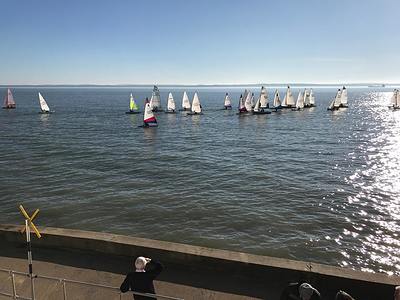
 .
.
Classes of Craft
The Club Rules extant in 1980 stipulated that, to occupy a space in the compound a boat must be a "sailing dinghy". At the 1980 AGM it was agreed that the Club should accept board sailors, the numbers to be limited at the Committee's discretion. The Club rules were to be altered accordingly. By 1982 there were 9 sailboards in the compound and the Sailing Secretary reported that a rack for 10 sailboards would be provided for the 1983 season. This was despite the Commodore saying "the Committee's option to control the numbers of windsurfers has at least ensured that we remain a dinghy club. Stokes Bay has virtually been taken over by 'surfers". By 1984 the sailboard rack had been abandoned "as insufficient members expressed an interest to warrant the expense". The updated Rules, approved in 1988 said, as they still do today "Any boat in the Club's compound must be a sailing dinghy".
Over the years various classes of boats have dominated racing in the Club. After the 1982 season, clearly wringing his hands, the Sailing Secretary, John Wyatt, asked if it was worth having a slow handicap series! There had never been more that 3 slow-fleet boats racing at a time. By 1995 the situation had improved and the Commodore reported a noticeable increase in numbers in the slow fleet and decline in the fast. This, he said, was due to the keen Solo-sailing membership and the aggressive sailing by 5 or 6 Mirror helms.
Lasers have always been popular. The Solo was ubiquitous for the first decade of this century but seems to have gone out of fashion since. As an illustration, of the helms who took part in the Combined Series of races in 2007, 32% sailed Solos and 21% Lasers*. The equivalent statistics for 2010 are 26% and 24%, for 2015 20% and 39% and for 2019 6% and 55%. (Laser* - an individual who sailed a Radial in one race and a 4.7 in another counts as one helm, not two).
Combined 7 October 2015

At the time of writing (June 2020), of the 122 boat spaces allocated in the compound, 32 are for Lasers, 14 for Wayfarers, 9 Solos, 7 Laser Stratos, 4 each RS Vision, Topper Topaz and Blaze, 3 each Bosun, Enterprise, Laser Pico, Mirror, Pacer, RS 400 and Wanderer, 2 each Laser 2000, Leader, RS Aero and Supernova. There are 19 other classes with only one of type in the compound. Note the 14 Wayfarers. In the last couple of decades these have rarely appeared in races but there has probably never been a Club cruise without a Wayfarer.
Duty Crews
Using volunteers, or "interested members", to manage racing soon proved inadequate. By the end of the 1970s the duty watch system was in place. At the 1979 AGM, in referring to "the usual problem of the OOD and safety boat driver not presenting themselves for duty", the Commodore began a tradition of bemoaning duty crew absenteeism that continues to this day. There have been several initiatives addressing this issue.
In 1988 there was a proposal, withdrawn before a vote, that all members pay a fee of £20 at the start of the season to be reimbursed at the rate of £5 per each duty watch completed. Failure to attend for duties or ensure that a substitute attends will incur a fine of £5 for each occasion. Identifying the safety boat driver within a crew began in 1989. In 1992 it was agreed that members should confirm with their crew leader their intention to attend 24 hours in advance of their duty. It was also agreed that members failing to demonstrate adequate reasons for not fulfilling duties would be liable to forfeit their boatspace. As a result those with poor duty records were invited to "account for your absences" as part of the membership renewal process of 1992/93. The procedure whereby the Sailing Secretary writes to absentees began in 1997. The distribution of duty crew lists to help members find substitutes began in 2005.
In 2019 (See Part 6, "Communications"), the Club adopted a new website with an integral Duty Roster system. This sends emails to inform members of their duties then reminders as these duties become more imminent. Using the system, members can invite and accept swaps. The system maintains a record of who is duty for any particular event thus providing an up-to-date list for the OOD. Has this reduced absenteeism? The jury is out!
Training
One of the original aims of the Seafarers Sailing Club was to encourage people to sail and to teach people to sail safely. Much of the early training was at evenings and weekends in 'Airborne'. The Club devised its own training scheme and awarded its own helmsman certificate.
'The News', 22 April 1971
 ..
.. 
Left: Stan Johnson showing George Hiser (12) and Howard Ellis (13) how to splice a rope
Right: Club Secretary, Bill Garment, working on some rigging with Peter Rayner
Although the Club became affiliated to the RYA in November 1963, it was not until 1975 that it sought formal RYA approval for the training provided. After considerable effort by certain members, notably Richard Van Kempen, and at considerable expense, in October 1975 the Club achieved Recognition as an RYA Teaching Institution. Initially the qualifications offered were Elementary, Intermediate and Advanced Certificates. In the late 80s this changed to National Dinghy Certificates Level 1, 2, 3 and 5. Between 1975 and 1995 it was not unusual for the Club to successfully train up to 23 members to Intermediate/Level 2 and up to another 13 to higher levels in a season. In 1997 the number on the Level 1/2 course was restricted to 18. To comply with RYA requirements regarding Patrol Boat cover for training, the maximum number was subsequently reduced to 12. Training expenses have always been kept to a minimum. Originally, with few qualified instructors and even fewer Club boats, experienced members and their boats were an integral part of our training programme. In the past decade the number of instructors has significantly increased and the Club now owns adequate suitable boats. In 2020 we have 11 Dinghy Instructors (5 of whom are Senior Instructors) plus 5 Assistant Dinghy Instructors. The Club currently owns Optimists, Fusions, Hartley 12.2s, Laser Stratos and an RS Venture. Now, all instructing is by qualified instructors and most training is carried out using Club boats.
The main training session each year coincides with the school summer half term break. For at least the past three decades, that week has been dedicated to the practical element of an RYA Level 1/2 (Start Sailing and Basic Skills) course. Each year also includes at least one advanced course - originally RYA Levels 3 and 5, more recently Seamanship, Start Racing and Day Sailing. The Club also trains its own Patrol Boat crews. This latter training usually takes place before the official start of the season.
In 2015 a second Level 1/2 training course was introduced running on Tuesdays and Saturdays from July to October. Over the next few years, this "summer" course morphed into a second one week course at the end of July to coincide with the beginning of school summer holidays. A new Junior Cadet Course (RYA YSS Levels 1-4) was introduced in 2019 for young cadets, aged between 5 and 11. The course was designed to run alongside the other summer course, but only in the mornings.
Training
2010 .  ..
..  . 2019
. 2019
Capsize recovery drills, an essential element of Level 1/2 course, were initially carried out at the Daedalus Boat Centre (now JSSC) at Hornet in Haslar Creek.
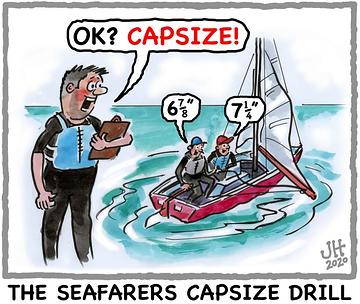
In 1995 and 1996 the venue was Royal Clarence Yard and from 1997 until 2008 it was the RNSC at Whale Island. In 2009 the drills were carried out in the River Hamble using facilities offered by Solent University's Watersports Centre, Warsash. This was not judged a success.
Since 2010, capsize drills have been carried out in the Solent on a convenient day during training week using a suitable Club dinghy.
Capsize Recovery Drills
1986 .  ..
..  . 2009
. 2009
The picture on the right shows capsize drills in the Hamble River in May 2009. It is a reproduction of a painting by Beverley Daniels which was presented to Dick Banks on his retirement as RYA Principal in August 2019.
Practice Sailing
Opportunities for novices to hone and extend their skills are considered as important as formal training and a number of Club initiatives have addressed this. Saturday morning sailing began in 1987 under the mentorship of Margaret Hyde and Edie Sampson and continued throughout the 1990s and into the new millennium with Tricia Gordon superseding Margaret as 'the other mother hen'. Although Saturday morning sailing was eclipsed by Tuesday evening sailing when the latter began in 1997, there has been a resurgence since 2015 when a second Level 1/2 training course was introduced running on Tuesdays and Saturdays from July to October.
Training and Practice Sailing on a Saturday morning - July 2015
 ..
.. 
The introduction in 1997 of "Informal" or "Practice" sailing on Tuesdays was part of a package of pro-cadet initiatives pursued by Mick Merson during his tenure as Commodore (seasons 1997 to 1999). 1998 saw the introduction of a scheme whereby experienced helms volunteered to crew in the Novice series. Novices found this very worthwhile especially as an introduction to racing. The photograph below shows a novice lady competing as the helm in a Ladies, Novices and Cadets Race in 2006 being crewed and coached by the dinghy's owner, a very, very experienced sailor.

Cruising
Situated on the Solent coast with many interesting rivers, beaches and havens to visit, it is little surprise that cruising has always been a part of the Club's activities.
There have been typically 10 cruises in each year's programme. The popularity of specific destinations, like the popularity of cruising, can change from year to year. There may, for example, be several years between successive visits to venues such as The Folly Inn, Bucklers Hard, Lepe or Bembridge. On the other hand, in 1973 Wootton and Ashlett Creeks were visited; I doubt there has been a season since that these two venues have not been visited.
Cruise to Ashlett Creek in the early 1980s (left) and a cruise to Wootton Creek in 2011 (right)
 ..
.. 
Mini Cruises: These appeared in the programme from 1989 to 1995. There were ten each year on Sunday afternoons after racing. The aim was to get more people on the water in an organised event and provide an introduction to cruising for the less experienced.
Round the Island: These cruises, aimed at the more experienced, began at the beginning of the 1980s and appeared in most annual programmes from 1980 to 2004. This article by John Glover published in the summer 1984 SSC magazine sets the scene:
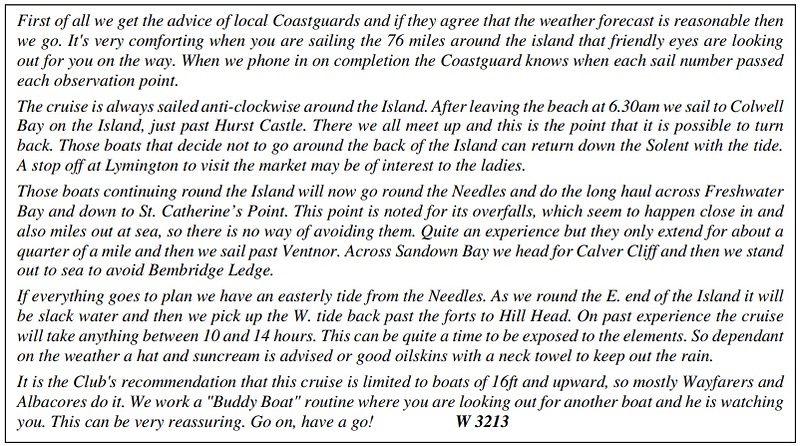
The 2004 Round the Island cruise was eventful. Just after 6am on Sunday 27th June, two Wayfarers and a GP14, accompanied by a 24ft motor-sailer, set of to circumnavigate the Island. Having made good time past St Catherine's Point, as they turned northeast they ran into gusty conditions and increasingly heavy seas. One of the Wayfarers capsized off Shanklin and inverted. The crew eventually righted the dinghy and landed at Shanklin to "take sustenance". The GP14 capsized a little further north losing its transom flaps. The crew righted it and managed to beach it at Sandown. The two Wayfarers, in winds up to Force 7 and very rough seas, eventually reached Hill Head by 7pm. One of the crew, John Hills, had survived the whole trip with a broken ankle. Having repaired the boat, the GP14 crew spent the night on the beach at Sandown - listening to the lions roaring in the nearby zoo. After a very pleasant morning sail down the Solent, they reached Hill Head at 9am on Monday.
Needles Astern - Round the Island Cruise - August 2018


Overnight Cruises: The first recorded Overnight Cruise was to Bembridge in 1977. Overnight cruises first appeared in the programme in 1999. On Saturday 17th July that year, 4 Wayfarers sailed to Bembridge. The 14 crew had a barbecue dinner followed by drinks at Bembridge Sailing Club before sleeping in their tents erected, with some difficulty, on the sand spit. On their way home on Sunday, the overnighters stopped at Woodside where they rendezvoused with 6 other dinghies and a RIB from the Club. Exactly one year later, 4 Wayfarers and a Wanderer sailed to Newtown Creek and pulled up on the edge of Shalfleet lake. The 13 crew put up their tents at Corf (Scout) campsite. The 6 cadets found lots of mud to amuse themselves. The adults enjoyed a walk to the New Inn and all enjoyed the glow worm display on the way back. The return journey on Sunday began with no wind and looked like a scene from "African Queen"; 5 dinghies being "walked" along the beach toward Gurnard. Eventually the wind appeared and the overnighters reached Hill Head at about 4pm.

There were trips to Newtown in 2001, Bembridge in 2002 and Newtown in 2003. In 2004 weather reduced the planned visit to Bembridge to a day trip. This ended with 3 Wayfarers paddling across the Solent from Woodside. An ad hoc overnight cruise to Newtown was fitted in a month later. Since 2005 many of those taking part have elected to go for two nights. There were two overnight cruises in 2006, both windy! In the 2018 Programme, the scheduled overnight cruise had to be cancelled because of strong winds. Despite this, Phill Borham (Cruise Secretary) and his father, Andy, went to a camp site by car/ferry. Tim Wadham then arranged an extra-to-programme (Ad Hoc) cruise to Corf Scout Camp which took place two weeks later. In 2019, the overnight cruise scheduled for Corf Scout camp was cancelled because of strong winds. Once again, Tim Wadham managed to squeeze in an Ad Hoc "overnight" a week later; with his sister Kay and Clive Dakin they stopped at Bembridge overnight on their way around the Island.
Since 1999 there have been a total 21 overnight cruises; 14 to Corf campsite, 3 to Bembridge (including 2019 above), 1 to Island Harbour Marina in the Medina River (2011), 2 to Lymington (2014 and 2015) and 1 (this year, 2020) to Medina Activity Centre.
Overnight Cruises Bembridge 2002 (left) and Newtown Creek (Corf Scout Camp) 2016 (right)
 ..
.. 
In addition to the programmed cruises, there have always been "unofficial" cruises. In the late 1990s Wednesday cruises became quite popular particularly with members who could take the day off. They were thus dubbed the "The 'Geriatric' Cruises"! They were not included in the Club's annual programme until that "went electronic" in 2015. The "Programme of Events" for 2015 to 2018 included "Mid Week Cruise - Destination: Ad Hoc" for each Wednesday from May to September. This disappeared when the new website, with integral programme, was introduced in 2019.
Commodore's Challenge
Since 1985, the Commodore's Challenge has been one of the highlights of the Club programme. For its first 15 years, it comprised teams taking part in two or three races. They were often relay races and occasionally a mix of formats, handicap and pursuit. During the 1990s the Challenge was almost always scheduled for the August Bank Holiday weekend. For the first decade of this millennium, a ploughman's lunch was the staple accompaniment. In 2011, a single team race followed by tea and cake, or cream scones, became the norm.
2011 also saw the Challenge develop as a charity event. Having attended the launch of the Mayor of Fareham's charities, the Commodore (Pete Cox) proposed that the 2011 Commodore's Challenge be used to raise funds for "Toe in the Water" (see Charities in Part 7). Feedback led the Commodore to propose that supporting this or a similar charity would be a feature of future Commodore's Challenges.
In 2016, the Commodore (Phil Warwick) decided to try something different. With an RYA Day Sailing Course and a full cruising programme, the Club was trying to encourage cruising during that season. In keeping with this theme, the Commodore's challenge was to set a new Seafarers' record for the number of boats/members participating in a Club cruise. The "Grand Cruise" as it was dubbed, took place on the 6 August with the Royal Victoria Yacht Club at Fishbourne the destination. The day was massively enjoyable and raised more than £105 for the Club Charity. In addition, several new Club records were set including the number of dinghies and members taking part, 17 and 47 respectively.
Commodore's Challenge 2016 - Grand Cruise to Royal Victoria Yacht Club
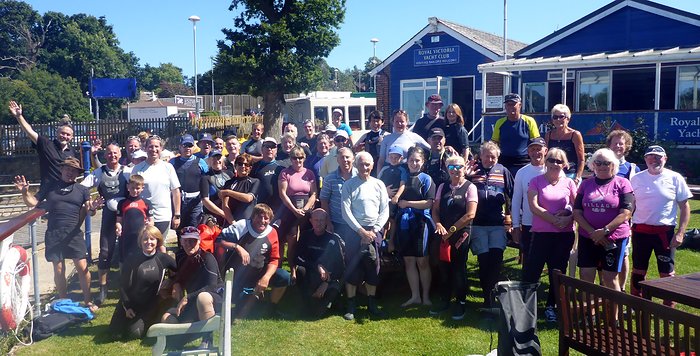
The 2017 Commodore's Challenge was a cruise to Portsmouth Harbour - another first for Seafarers. With lunch booked at Hornet Services Sailing Club. The day, which was accessible to sailing and non-sailing members, was thoroughly enjoyable with another record broken - 48 (of the 61 participants) travelled by boat. A repeat of this cruise was scheduled in 2018. Sadly, storms precluded any sailing. Despite this, sixty members travelled by road to enjoy lunch and good company at Hornet Services Sailing Club.
In 2019, attention returned to racing. The target set for the Commodore's Challenge was to achieve the best attended race. The plan was to use a Committee Boat to start the Half and Under Half Ton Cup races simultaneously. Forty-nine sailors crewing thirty-four boats contested the Commodore's Challenge on the 27 July. If not a new record, 34 was higher than any entry found in the Club archives. More importantly, everyone had a great day and £221 was raised for the Club's charity.
Club Dinghies
For the first half of the 1970s the Club had three boats: "Airborne" (see pages 3- 4), the self-built GP14 and an Enterprise. The Enterprise was fitted with an outboard motor and used as a rescue boat. In 1977 the Club invested in a Wayfarer Mk 1 (Golden Eye - WF3282); it was of GRP construction to reduce the maintenance task. In 1979 the GP14 was sold and "Airborne" was donated to Laurie Racey and Ernie Hiser. "Airborne" remained in the Club until early 1992 when Laurie and Ernie donated it to the RAF Aviation Museum at Tangmere.
In 1984 two Mirrors were donated to the Club. The following year the Club sold 2 wooden Leaders it had been presented with. The first Topper was bought in 1987, the second in 1992. By 1997 the Club owned a Wayfarer, 3 Toppers, a Mirror, a Skipper and a 420. The 420 was sold the following year. It was considered unsuitable for the Club's training needs.
In 1989 a proposal to impose a fee of £5 for the use of the Club Wayfarer for cruising purposes was approved by a majority vote of 22 votes for, with 18 against. This remained in force for one year. At the next AGM, in 1990, a proposal was tabled by Vic Bryant to rescind the charge. Vic argued that the imposition of a charge contravened the original aims and intent of the Club in that equipment should be provided for the use of members indifferently for racing, training and cruising. The proposal was carried by a majority of 13 with 29 abstentions.
At the end of 2006, the Club bought a Topper Topaz on attractive terms from a departing member. This was to replace the Club Mirror and provide a useful addition to the training fleet. Although this was a Trez variant, it was rarely rigged as an asymmetric. The Topaz class was becoming quite popular in the Club. In March 2008, the Club purchased an RS Vision which had become surplus to requirements at the Portsmouth Outdoor Centre (POC). This provided another 2-seat trainer and proved especially useful when the Club began carrying out capsize recovery drills in the Solent. In 2010, the Club purchased a second Mk 1 Wayfarer and a second Topaz with the help of a very generous donation from John and Mavis Harmer. As a token of appreciation, the Club named its Topaz dinghies 'John' and 'Mavis'.
Topaz Dinghies 'John' and 'Mavis' June 2010

At the end of 2014 in an unusual initiative, the Committee accepted ownership of a member's RS Venture in exchange for prepayment of renewal fees. Then in 2015 the two Topaz were replaced by three Hartley 12.2s. In 2017, a rather leaky Wayfarer was replaced by a Laser Stratos.
By 2018, Wayfarer "Golden Eye" (3282) had been in the Club's possesion for 41 years! With the help of a generous grant from Hampshire County Council, a generous donation from Mavis Harmer and the sale of "Golden Eye", the Club acquired its second Stratos and invested in three Hartley Alphas (Optimists). The Committee thought the time was right to offer members' children, grandchildren, nephews and nieces a chance to sail at the Club. As mentioned under Training above, the following year the Oppies were put to good use when a new Junior Cadet Course was introduced for young cadets, aged between 5 and 11.
Racking for the Optimists May 2018

At the beginning of 2019, the Club was loaned a Fusion dinghy which proved both useful and popular. In June, the Club bought the boat. This was with the aid of a generous donation from the estate of Nicky Dunk who had sadly lost her fight against cancer while serving as Rear Commodore. This use of the donation was suggested and approved by Nicky's siblings, Tim and Kay Wadham, both serving on the Club Committee at the time.
In March 2020 the Club purchased a second Fusion which it named "Mavis" in honour of Mavis Harmer whose most recent donation to Seafarers had helped pay for the new dinghy. In June 2020 Bill Cunningham, Club stalwart and friend to all, very generously donated his almost-new Fusion, "Fusionista" to Seafarers.
Thus, by mid 2020 the Club owned the following boats: one RS Venture, two Laser Stratos, three Hartley 12.2, three Fusions and three Optimists. This fleet was considered optimal for formal RYA training, the development of personal sailing skills and to encourage new members.
Club RIBs
The Club's first RIB, a 4 metre Avon Searider, was bought in 1978 after an EGM at which the benefits of RIBs as rescue boats was convincingly argued. The second Searider was purchased in 1993 (see "A New Boathouse" in Part 2). In 1998 the newer boat was upgraded with hydraulic steering gear. The older boat, which was used mainly as a backup and for safety boat training, was updated to the previous standard of the newer one primarily by fitting a centre console. New outboard motors were bought in 2000 and in 2007 the latter was one of the last 2-stroke engines sold in the UK.
Despite their significant ages, both boats were kept in remarkably good condition by the cosseting they received from a succession of dedicated Bosuns. By 2016, Patrol Boat 1 had been in use for 23 years and PB2 had accumulated 38 years of service with SSC. After much research, a new Solent RIB 4.6 with a 40hp Suzuki engine was purchased with the help of a generous grant from the Hammond Memorial Hall Trust and the sale of the aged Searider. A training programme during July and August ensured that all patrol boats helms and crew were familiarised with the larger and heavier new RIB.
Patrol Boats Searider in 2010 (left) and Solent 4.6 in 2016 (right)

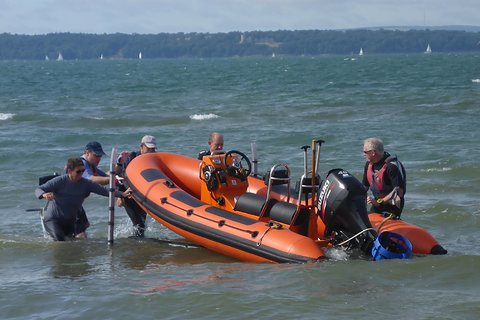
VHF
During races in the early 90s, CB radios were used for communication between the safety boat and shore. At the beginning of 1994 the Committee was persuaded that VHF communications should be introduced. Advantages included improved reliability and the ability to communicate with other VHF users including HM Coastguard. In March, a VHF course at the clubhouse was attended by approximately 25 safety boat drivers and watch leaders (OODs) who, thus trained and £21 poorer, left with operator's licences. By May the Club had procured two Navico Axis 200 hand-held transceivers (£450 each) and held two ship radio licences (£22 pa each). The Club elected to use channel M2 (161.425 MHz) allowing the radios to be used by members not holding an operators licence.
In June 2000, during an RYA inspection, it was recommended that the Club consider introducing a VHF base station so that both safety boats could carry the portables. In July the appropriate licence was obtained (then £75 pa . . and it still is!) and Ian Tolputt (father of Club member Paul) generously donated, modified and installed a VHF transceiver in the signal tower.
In June 2005 a third Navaco hand-held transceiver was purchased (£440) and the extra licence obtained (by then down to £15 pa. . . now free!).
At the 2005 AGM the poor reliability of the VHF radio system was discussed. In January 2006, Murphy Telecoms was commissioned to test the system. A number of defects were found; the system was deemed beyond economical repair. A new radio, an Icom IC-M401 VHF Marine, was supplied and installed as part of a complete system with a fixed station aerial and a second hand power supply at a cost of £455.
The Club began updating its portable transceivers in 2010 when it bought a modern waterproof and buoyant transceiver for £130. Further handheld VHFs were bought in 2013 (£94) and 2018 (£190).
In 2014 the Club bought a set of four "walkie talkies" (UHF handheld transceivers) for use by beach crew during racing and for boat-to-boat communication when cruising. Their poor performance and reliability meant they soon fell out of favour.
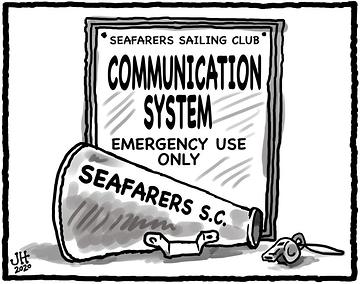
Last updated 15:02 on 9 April 2024
